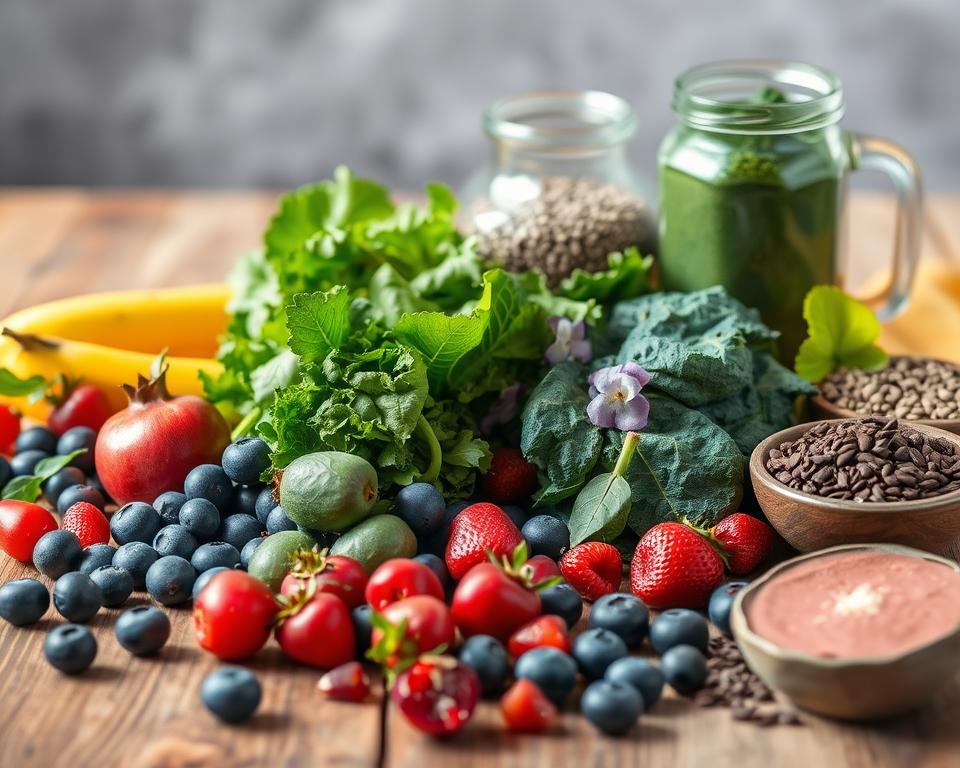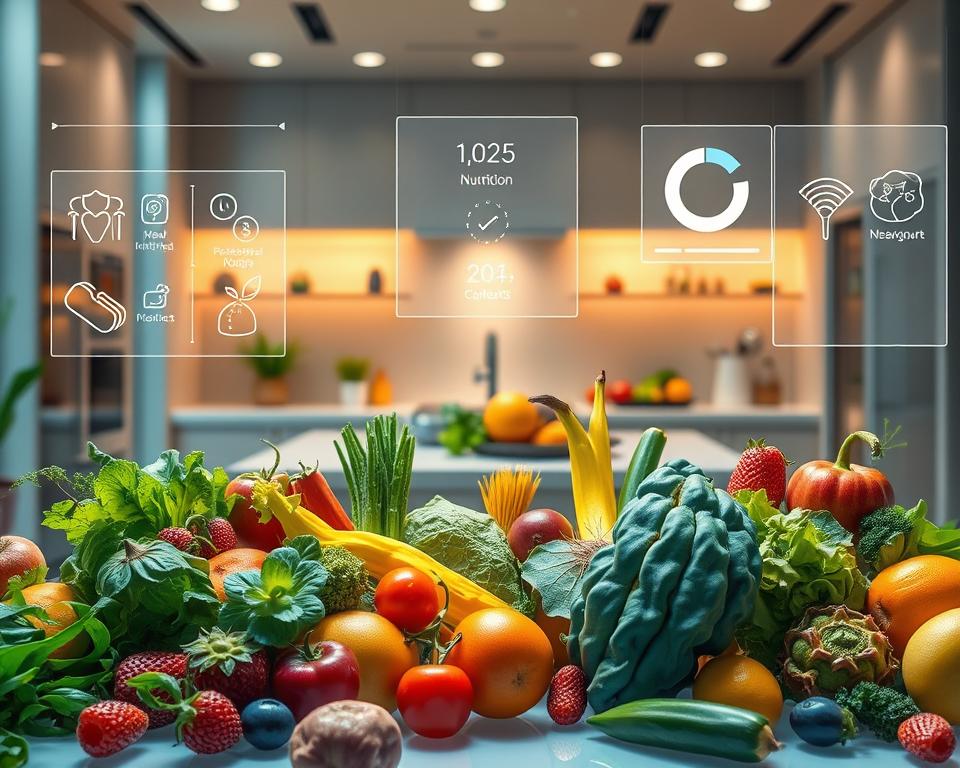Anúncios
balanced diet guide—could one simple plate change make your daily meals clearer and less stressful?
You’ll get a practical, evidence-informed plan you can use today without rigid rules. This short introduction explains why this Ultimate Guide matters now in the United States. Food choices, work hours, and convenience shape how you eat. Simple plate models can cut through the noise.
Why trust this approach? It borrows from the Harvard Healthy Eating Plate and USDA MyPlate to focus on plate portions instead of single superfoods. That helps you build a day of meals that supports health and fits your schedule without counting every calorie or memorizing long lists.
Use this guide to learn portion ideas, smart swaps, and how to match intake to your needs. It is educational, not medical. For personalized care, check in with a registered dietitian or clinician.
Introduction: Why a balanced diet guide matters right now
Everyday food choices in the U.S. are shaped by time pressure and a flood of ultra-processed options. This reality makes it harder for people to choose meals that support long-term health and energy.
Anúncios
Evidence-based plate models translate nutrition science into simple plate visuals you can use at meals. Harvard’s Healthy Eating Plate emphasizes food quality and urges water or unsweetened tea, limits milk and juice, and avoids sugary beverages. The USDA MyPlate Plan personalizes patterns by age, sex, height, weight, and activity so you can match calories to your needs.
This Ultimate Guide is educational and practical. It shares sound recommendations and tools, but it does not diagnose, treat, or promise specific results. Outcomes vary by body, lifestyle, access, and preferences.
If you have specific health conditions or need tailored advice, ask a registered dietitian or clinician. Small, consistent changes—focusing on the nutritional value of vegetables, fruits, whole grains, healthy proteins, and oils—tend to be more realistic and lasting than dramatic overhauls.
Anúncios
Balanced diet basics: What “balanced” really means
Start with a simple definition: a steady eating pattern focuses on food quality and real meals more than strict rules. It means you regularly include vegetables and fruits, whole grains, healthy protein, and a small amount of healthy oils while cutting back on highly refined and sugary foods.
Diet quality over quick fixes
Quality matters more than perfection. The type of carbohydrate and fats you pick affects energy and nutrition more than short-term calorie counting. Whole and minimally processed foods supply fiber, vitamins, and steady fuel for your body.
The core food groups and why variety matters
- Vegetables and fruits: aim for color rotation across the week.
- Whole grains: switch among oats, brown rice, quinoa, and whole-grain pasta.
- Proteins: mix fish, poultry, beans, nuts, and plant proteins for broad coverage.
- Oils and fats: favor unsaturated oils in small amounts and limit saturated sources.
Use plate proportions as a simple cue so you don’t have to count every calorie. Models like the Healthy Eating Plate and MyPlate show how groups and portions add up over time. If you have special needs, ask a professional to personalize your plan.
Use the Healthy Eating Plate and MyPlate together, practically
Both models give clear cues you can use at every meal. The Healthy Eating Plate focuses on food quality and beverage choices. MyPlate helps you personalize portions by age, sex, and activity. Together they make a simple, flexible way to plan real meals.
Half your plate vegetables and fruits, with color and variety
Fill half your plate with vegetables and fruits using color as a cue. Skip fries and starchy potatoes for this slot on the Healthy Eating Plate.
Choose frozen or fresh veggies, and double them if you can’t see them on the plate.
Quarter whole grains, quarter healthy protein
Make one quarter whole grains—brown rice, oats, quinoa, or whole-grain pasta.
Reserve the last quarter for lean protein like fish, poultry, beans, or nuts. Limit red meat and avoid processed meats.
Healthy oils in moderation and staying active
Add a small drizzle of plant oil—olive or canola—for cooking or dressing. Pair meals with movement when you can to support appetite and energy.
Applying plate methods when meals aren’t on a single plate
Translate the plate to bowls, sandwiches, soups, and burritos by thinking in proportions. Load vegetables first, pick whole-grain wraps or bread, and add a reliable protein source.
Example: a grain bowl for lunch (greens + roasted vegetables + quinoa + grilled salmon + olive oil) or a stir-fry for dinner (mixed vegetables + tofu + brown rice).
- If grains are refined, swap for whole versions.
- If vegetables are missing, double them.
- MyPlate can add a dairy side if that fits your preferences.
Calories and portions: Finding the right amount for your day
Daily calorie targets change with your routine and sex, but simple cues can keep portions sensible. Many adults average about 2,000 calories per day, yet active young men may need 2,800–3,200 while sedentary older adults often fall between 1,600–2,400.
Think of that range as a starting point, not a rule. Your personal needs depend on age, activity, and weight goals. If you aim to maintain or change weight, small adjustments over weeks work better than extreme cuts.
Practical portion cues:
- Plate portions: half vegetables and fruits, one quarter whole grains, one quarter protein.
- Hand guides: palm for protein, fist for grains, thumb for fats like oil or nut butter.
- Swap examples: whole-grain toast for a pastry; sparkling water for soda; fruit for candy.
Pick nutrient-dense foods and limit empty-calorie items like sugary drinks and fries. Include protein and vegetables to feel full on fewer calories. Measure high-fat ingredients lightly—oil adds flavor but also concentrated fat per spoon.
If you have specific goals or conditions, a registered dietitian can tailor needs to your life. Check hunger and fullness cues and adjust portions gradually.
Vegetables and fruits: Everyday strategies to boost nutritional value
Adding more vegetables and fruits can raise the nutritional value of your meals without extra time. Pick colorful produce across the week so you get dark greens, orange/red, cruciferous items, and berries.
Why potatoes and fries don’t count on some models
The Healthy Eating Plate treats potatoes and French fries more like a starch than a vegetable. They raise blood sugar more than most non-starchy vegetables, so models separate them to steer you toward higher-value choices.
Fresh, frozen, canned, and dried: choosing smart
Fresh is great, but frozen and low-sodium canned produce keep you covered on busy days. Dried fruit works in small portions—watch sugar and serving size.
Real-life prep ideas that fit busy weeks
Try a sheet-pan of mixed vegetables tossed with a splash of olive oil and simple seasonings. Boost salad kits with canned beans for protein. Microwave-steam frozen veg for fast sides.
- An example plan: fruit at breakfast, a vegetable at lunch, two vegetables at dinner, plus a fruit snack.
- Keep smoothies small and favor whole fruit to limit added sugar.
- Rotate colors and roast with minimal herbs so veggies taste great with little effort.
Whole grains over refined grains: Better energy, better fiber
Choosing whole grains is an easy change that helps steady blood sugar and keep you full longer. Whole options release energy more slowly than refined white bread or white rice, so your body avoids sharp insulin spikes.
Swap in these foods:
- Brown rice instead of white rice.
- Steel-cut or rolled oats for instant oatmeal with added sugar.
- Quinoa as a base for bowls and salads.
- Whole-wheat pasta for pasta night.
Practical label tips
Read the ingredient list. Look for “100% whole grain” or “100% whole wheat” as the first item. Avoid products where refined white flour is the main grain.
Easy recipes and meal ideas
Try a quinoa-vegetable bowl with beans and a light olive oil drizzle. Make oatmeal topped with nuts and fruit for breakfast. Toss whole-wheat pasta with seasonal vegetables and a lean protein for a quick dinner.
“Whole grains fill the plate’s grain quarter while pairing naturally with vegetables and protein.”
Why fiber matters: Fiber helps you feel full, supports digestion, and can cut how much higher-fat extras you reach for. Buy brown rice and oats in bulk and freeze extra cooked grains to save time and money.
Protein power: Fish, poultry, beans, and nuts
Picking the right protein source makes meals more satisfying and easier to balance. You’ll feel fuller with less snacking when meals pair protein with vegetables and whole grains.
Healthy animal proteins and quick ideas
Choose fish and poultry for frequent meals. Aim for two portions of fish weekly, with one oily fish like salmon or trout for omega-3s.
Fast ideas: sheet-pan chicken with roasted veg, baked salmon with lemon, or canned tuna mixed with white beans and herbs.
Plant proteins you can rotate
Beans, lentils, peas, tofu, and tempeh deliver fiber and steady energy. Use them as main or as a mix-in to stretch meals.
Try lentil chili, a tofu stir-fry over brown rice, or a chickpea salad with whole-grain pita.
Limit red meat and avoid processed meats
Keep red meat portions modest and pick lean cuts when you include them. Avoid processed meats like bacon, sausage, and deli slices; they raise sodium and may increase long-term risk.
- Mix animal and plant sources across the week: salmon or trout once or twice, chicken or turkey a couple times, and plant options most days.
- Prep-friendly meals: lentil chili, tuna-and-white-bean salad, tofu stir-fry, sheet-pan poultry.
- Rotate sources to get omega-3s from fish and fiber from beans.
“Protein helps with satisfaction and works best alongside vegetables and whole grains for balanced meals.”
Dairy and fortified alternatives: Getting calcium, protein, and vitamin D
Milk, yogurt, and fortified plant drinks are practical sources of calcium and vitamin D for many people. You’ll decide whether dairy fits your meals based on taste, tolerance, and your nutrition needs. The Healthy Eating Plate suggests 1–2 servings of milk or yogurt per day.
Picking lower-fat, lower-sugar options
Choose lower-fat and unsweetened versions when you can. Compare labels and avoid flavored products with added sugar.
- A serving idea: about 200 ml milk or 125 ml plain yogurt.
- Look for “unsweetened” and check the ingredient list first.
- Keep servings modest and match them to your overall goals and needs.
Unsweetened, calcium-fortified non-dairy drinks
If you prefer non-dairy, pick unsweetened soy, almond, or oat drinks fortified with calcium and vitamin D. You can also get calcium and protein from other foods, such as calcium-set tofu or canned salmon with bones.
Fats and oils: Choosing types that support heart health
Fats come in different forms, and knowing which to favor makes cooking and shopping simpler. Use small swaps to keep flavor while limiting extra calories.
Unsaturated oils to favor
Choose plant oils and oily fish
Pick unsaturated oils like extra-virgin olive, canola, sunflower, or avocado for dressings and most cooking. These oils are common sources of unsaturated fat and work well at low to medium heat.
Include fish such as salmon or trout a couple times weekly to add omega-3s. Rotate plant and marine sources of fat instead of relying on one type.
Trans fats to avoid
Steer clear of partially hydrogenated oils
Avoid foods listing “partially hydrogenated” on labels and many packaged baked goods. Trans fats raise LDL cholesterol and offer little nutritional value.
Saturated fats to limit and practical tips
Swap, measure, and flavor smartly
Limit saturated fats like butter, ghee, and tropical oils. Use olive oil for finishing and canola or avocado oil for higher heat. Choose lean meats and bake, grill, or steam more often.
Measure oil with a spoon instead of pouring, and build taste with herbs, citrus, and spices so you need less oil. Remember: oils are calorie-dense, so small amounts go a long way.
- Pantry short list: extra-virgin olive oil (finishing), canola or avocado oil (cooking), and a neutral oil for baking.
- Avoid: partially hydrogenated fats and highly processed snacks.
- Practical rule: favor unsaturated fats to support a heart-friendly eating pattern without strict limits on healthy fats.
Sugar, salt, and highly processed foods: Minimizing empty calories
Learning a few reading tricks makes it easier to choose lower-sugar and lower-sodium options at the store. You don’t need to be strict to cut empty calories. Small swaps add up.

Spotting added sugars in drinks and snacks
Look for sugar near the top of the ingredient list and for hidden names like dextrose, maltose, or high-fructose corn syrup.
Tip: Choose water, sparkling water, or unsweetened tea and coffee instead of sweetened drinks to cut sugar consumption fast.
How processed meats and excess sodium raise risk
Limit processed meats such as bacon, sausage, and deli slices. These products often contain high sodium and preservatives that can raise long-term risk for disease.
Compare front-of-pack cues like traffic-light labels and the nutrition facts panel to lower the amount of added salt and unhealthy fats.
“Cook more from basic ingredients so you control the type and source of sugars, fats, and salt.”
- Swap chips and candy for fruit, nuts, or air-popped popcorn to lower empty-calorie foods.
- Watch for trans fats and choose minimally processed proteins and plenty of vegetables.
- Measure sauces and dressings so the amount of added sugar and salt stays small.
Hydration and drinks: Water first, smarter choices for your day
Small swaps in what you sip can cut extra calories and support steady energy all day.
Make water your default. Aim for 6–8 glasses of fluids across the day and reach for plain water first.
Water, tea, and coffee with little or no sugar
You’ll put water first, then choose tea or coffee with little or no sugar to keep hydration simple.
Unsweetened beverages add fluid without added sugars or extra calories. If you like flavor, try citrus slices or fresh herbs.
Limits for milk, juice, and sugary drinks
If you include milk, keep it to 1–2 servings per day and pick lower-fat, unsweetened options when helpful.
Limit juice to a small glass (about 150 ml) as a once-a-day choice and favor whole fruit instead.
Avoid sugary drinks most days to reduce excess calorie intake and improve overall consumption patterns.
Alcohol awareness: calories and moderation
Alcohol can add many calories quickly. Watch portion size and frequency to lower long-term risk.
Moderation helps most people manage daily calorie goals: count drinks in your weekly plan and choose lower-calorie options when you do drink.
- Read café menus: ask for no syrups and pick plain milk or unsweetened alternatives.
- Flavor water with a splash of 100% juice or a lime wedge instead of sweet mixers.
- Keep the amount of high-sugar beverages low so your overall pattern stays simple and sustainable.
“Water first, then tea or coffee with little or no sugar — simple, effective choices for daily hydration.”
Smart shopping and food labels: Turning intentions into your cart
You can shop confidently when you know which front-of-pack signals to trust. Quick label checks help you spot high sugar, saturated fat, and sodium so you avoid common pitfalls at the shelf.
Front-of-pack cues and ingredient lists
Scan front labels first for color-coded cues that flag energy, fat, saturated fat, sugar, and salt. Aim for more green and amber, fewer reds.
Then open the package and read the ingredient list to confirm real sources and fewer additives. Watch for hidden sugars and words linked to added salt or unhealthy fats that raise cholesterol.
Budget-friendly strategies for whole foods
Shop core groups first: produce, whole grains, and healthy protein sources. That keeps meals simple and limits impulse buys.
- Compare products by nutritional value, not just price per unit.
- Stock staples: dried beans, brown rice, oats, frozen vegetables, and canned fish in water.
- Choose small bottles of olive or canola oils so they stay fresh and cost less long term.
Recommendation: plan a few meals before you shop so you buy only what you’ll use and reduce waste.
Putting meals together: Simple, balanced examples you can use
Use a few repeatable meal templates to cut decision fatigue and keep your week practical and varied. Work from the plate model: half vegetables and fruit, one quarter whole grains, one quarter healthy protein, plus a small amount of oil and water first.
Quick plate examples with pasta, rice, beans, and vegetables
Fast dinner ideas: whole-grain pasta tossed with sautéed vegetables and chickpeas, or a brown rice bowl with black beans, peppers, and grilled chicken.
Microwave-friendly options: a stir-fry kit with pre-cut vegetables, precooked brown rice, and rotisserie chicken reheated with a splash of olive oil.
Breakfasts, lunches, and dinners that travel well
Make-ahead breakfasts: overnight oats with berries and nuts, or egg-and-vegetable wraps on whole-grain tortillas you can eat cold or warm.
Lunch box example: mixed greens + quinoa + roasted vegetables + tuna on the side with an olive oil vinaigrette.
- Snacks that fill gaps: fruit plus yogurt, carrots with hummus, or a small handful of nuts.
- Use plate proportions to adapt cuisines: tacos with extra vegetables, grain bowls, or salads with a lean protein.
- Shortcuts: pre-cut vegetables, canned beans for quick protein, and rotisserie chicken to speed prep.
“Keep meals simple: one familiar template, small swaps, and you’ll save time while eating well.”
Tip: plan two base meals and rotate flavors so packing, reheating, and travel stay easy and useful for your daily diet.
Personalizing your plan with tools and small habits
Start by picking one small habit you can keep for a week — it helps you personalize without overwhelm. Use that win to build another habit the following week. Little steps add up and make the changes sustainable.
Use MyPlate as a starting pattern. It estimates portions and calories based on age, sex, and activity so you get a simple baseline that matches your needs. Track lightly: snap a meal photo or tick a box for vegetables, whole grains, and protein.
Practical ways to keep tracking simple
Keep a quick checklist or 1–2 photos a day. That way you notice patterns in appetite, energy, and weight without logging every ingredient.
Adjusting for culture, preferences, and dietary needs
Make meals that reflect your culture and favorite flavors while following core proportions. Swap local food sources and recipes so changes fit your life.
- Start small: add one vegetable to lunch or swap one sugary drink for water.
- Plan for travel: pack portable proteins, whole grains, and fruit.
- When to seek help: check with a registered dietitian for tailored recommendations if you have health questions or specific goals.
“Personalization is a simple, flexible way to make lasting changes in how you eat.”
Conclusion
A single simple swap at your next meal can start a chain of better choices.
Pick one plate-based change—more vegetables, swap refined grains for whole grains, or add fish or beans for protein—and use it today. Small steps taken every day add up to real shifts in how you eat and feel.
Remember this is educational and not a medical plan. Managing weight and long-term health involves many factors, and individual results vary. Bookmark the Healthy Eating Plate resources and try the MyPlate Plan tools to keep choices practical and personalized.
For tailored advice, check in with a registered dietitian or your clinician. Focus on consistency, not perfection, and lower long-term risk by choosing steady, sensible habits. For a quick refresher, see a balanced eating overview at Healthline.



